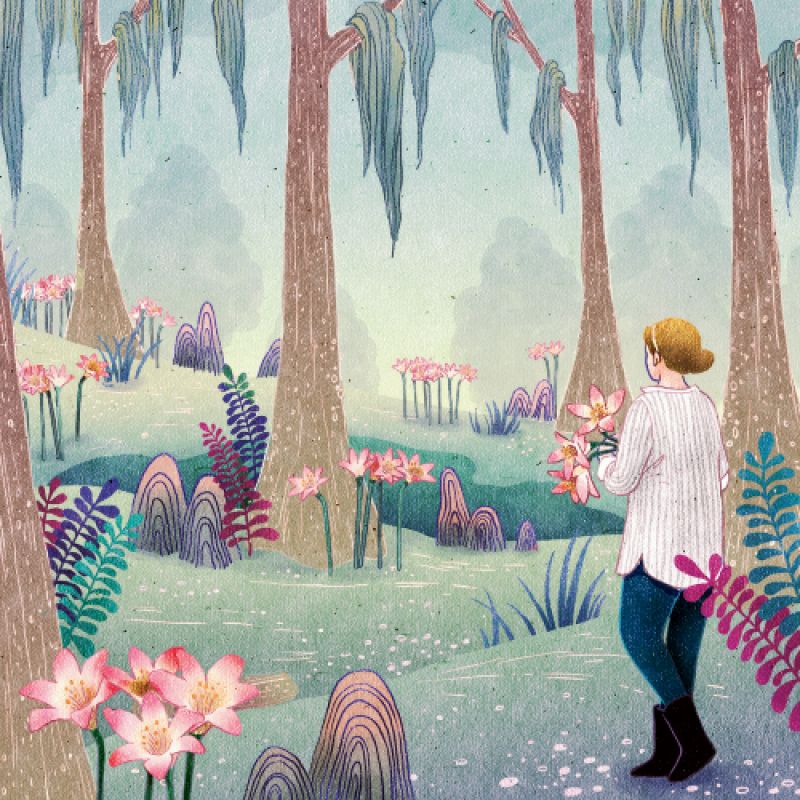
Spring is here, and the Lowcountry has exploded into a wonderland of Technicolor splendor. Despite the beauty of the city in all its garden glory, I find myself drawn to hidden spots in boggy basins to seek our most exotic wildflowers—Carolina jessamine, wild azalea, dogwood, and the elusive Atamasco lily (Zephyranthes atamasca), better known as the “naked lady.”
This is an annual pilgrimage for me, one I learned at my flower-addicted mother’s bended knee. For indeed, the quest for the naked lady lily—an understatedly elegant plant with a delicate star-shaped white bloom atop one slender green stalk “naked” of any leaves—requires much leaning, stooping, and clambering across moss-covered fallen trees and gnome-like cypress knees.
My mother, Elizabeth Smith, was an indomitable spirit, all five-foot-zero of her, who loved flowers. No matter the time of year, there were always blooms in the house, vases spilling over with wildflowers or the annuals and perennials she grew in the yard. We tromped into the woods before Thanksgiving in search of partridge berry and again before Christmas seeking pine and cedar for garland-making.
Come Easter, it was time for naked lady lily hunting, perhaps my favorite of our wildflower jaunts. Back then, we lived near Huger, and a good picking spot would usually be espied during our drives from plantation to town. (Those were the days when one hardly saw another car on Highway 41 and Daniel Island was nothing but farmland.) The real secret was to find a place where woods fell off into a low, swampy bog. Then, we’d pull over and brave the underbrush with a long stick and, stomping heavily so Mr. Snake could hear us, we would intrepidly enter the magical morasses preferred by the native plants.
In these secluded spots, naked ladies grow in colonies, making their territory a fantasia of dozens, sometimes hundreds, of seductive white blooms. Their realm is Eden-like, silent except for birdsong and the gentle whisper of the wind against the trees. It is a fairy-tale illustration come alive and made lush by the scents of musty loam and the lavender perfume of wisteria, as well as the shafts of filtered light that bathe the soft undergrowth in a wash of exhilarating green. One half expects a leprechaun to step out from behind a tree stump or
Persephone to emerge from the underworld to bring spring’s renewal.
Like Persephone’s journey, my annual trek into the swamp for naked lady lilies remains as reliable as spring itself. I follow in the mud-coated footsteps of not only my mother but thousands of Lowcountry folk who, no matter the century, sought an Easter bouquet of these beauties for the table. Before the advent of florists, these blooms (also known as “resurrection” lilies) were traditionally used as church flowers on Easter morning. Herein lies one of my mother’s most beloved anecdotes, so oft-told by locals it is very likely true:
It happened in the early 1950s, when two members of the altar guild at St. Michael’s Episcopal Church were preparing for Easter services. As one of the ladies was leaving to gather a few necessaries, the other suddenly remembered that she forgot to tell her friend to pick up the flowers. It is said that she ran out of the front door of the church and, right there on the corner of Broad and Meeting streets and in front of an astounded group of tourists, shouted, “Don’t forget the naked ladies for the altar!”
The story still makes me smile. Mother was a member of the altar guild, so for all I know, she was telling the story on herself. Truth be told, she was a bit over the top when it came to flowers. When she died, I inherited 185 hibiscus plants. It really is true that her last words to me were: “Don’t forget, fertilize once a week.”
Mother passed away in May of 1993, on the day after Mother’s Day, to be precise. Perhaps my annual quest for naked ladies is a subconscious attempt to bring her back. I will thus enter the swamp again this spring to seek a bouquet of these stately, rare blooms. I will stomp loudly and carry a big stick to offset any chance meetings with Mr. Snake. And, if only in my heart, I will be with my mother once again, sharing the enchanting world of woodsy swamp awash in the white-blossomed glory of naked ladies in full bloom.
Suzannah Smith Miles is the author of many books on Lowcountry history, including The Islands: An Illustrated History of Sullivan’s Island and Isle of Palms.